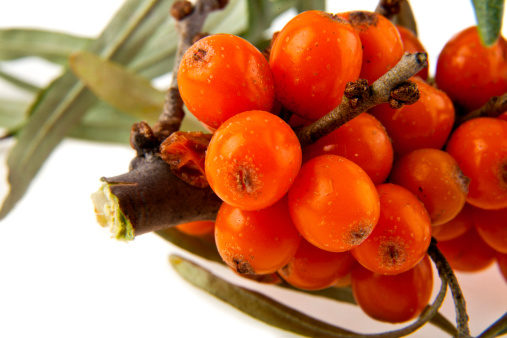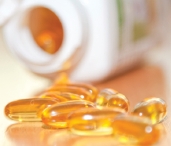While used in Europe and Asia for centuries, the Himalayan superfood sea buckthorn has only taken hold in North America relatively recently (1). Despite this, it is already making quite a name for itself, drawing interest both from the scientific community and shoppers for many purported properties. While one of the most common uses for sea buckthorn is in topical skincare products, new knowledge is showing that the miracle berry has impressive applications as a dietary supplement (2).
The Facts behind the Miracle
While some may dub sea buckthorn as a “miracle berry,” in fact its branches, leaves, berry skin, pulp and seeds are all said to have beneficial properties. Natural products companies are formulating sea buckthorn in a variety of delivery systems, including seed and fruit oils, liquids and gel caps. Part of this versatility is due to the diverse nutrient profile of sea buckthorn. Its strong fatty-acid content includes omega-3, -6, -7 and -9, a combination that is extremely rare in Mother Nature. These omegas, combined with sea buckthorn’s high antioxidant content, lend it its primary benefits with regard to skin care, fighting free radicals and supporting healthy aging. In fact, sea buckthorn is one  of the richest plant-based sources of omega-7 available. In addition, sea buckthorn has a very high vitamin content, possessing 10 times the vitamin C of oranges and being the third highest source of vitamin E in the plant world (3).
of the richest plant-based sources of omega-7 available. In addition, sea buckthorn has a very high vitamin content, possessing 10 times the vitamin C of oranges and being the third highest source of vitamin E in the plant world (3).
Weight Loss
One factor behind sea buckthorn’s rise in mainstream popularity was its 2011 appearance on The Dr. Oz Show, where sea buckthorn oil was primarily promoted as a weight loss aid in addition to its topical properties. As host Mehmet Oz, M.D., explained it, the presence of the rare omega-7 fatty acid signals the body to stop storing fat, enabling quick and prolonged weight loss. This conclusion was based off of a study he cited comparing the weight and overall health of rats supplemented with sea buckthorn against a control group (2). Anecdotal evidence from people who followed this advice lends support to these claims, with one person claiming not only to experience weight loss, but appetite reduction as well (4).
At least one clinical study examined the benefits of sea buckthorn on weight loss, where sea buckthorn and bilberries were administered to 110 overweight and obese women to determine their effects on variables related to metabolic disease. The study administrators concluded that different berries as well as different berry fractions, like sea buckthorn oil and phenolic extract, had various positive effects on the participants (5).
Future Possibilities
Between its traditional use in Europe and Asia and its growing popularity in the West, many other studies are taking place to determine new properties and uses for sea buckthorn. While further study will need to take place, the possibilities span a wide range. Many of these studies center on sea buckthorn’s flavonoid content, with one of the largest areas of interest being whether the berry can  benefit cancer patients. One study showed an extract containing sea buckthorn flavonoids protected bone marrow from radiation damage while promoting cell recovery in laboratory animals (6). Several other studies show inhibition of cancer cells and carcinogenic factors in animals (7).
benefit cancer patients. One study showed an extract containing sea buckthorn flavonoids protected bone marrow from radiation damage while promoting cell recovery in laboratory animals (6). Several other studies show inhibition of cancer cells and carcinogenic factors in animals (7).
Sea buckthorn could also potentially support heart health. In one double-blind trial, patients with ischemic heart disease were administered sea buckthorn flavonoids over a six-week period. At the conclusion of the trial, patients experienced a decrease in cholesterol and improved cardiac function, with no harmful side effects (8). Another study suggested the mechanism behind these results may be the regulation of inflammatory mediators, but this has yet to be confirmed. China already has a liquid preparation of sea buckthorn flavonoids with carthamus and licorice on the market, said to support blood circulation and cardiac recovery (7). Studies are also underway regarding sea buckthorn’s effects on several other conditions, including skin health, gastric ulcers, liver cirrhosis, senility and immune deficiencies, though these require more research to yield concrete results. WF
|
Alternative Omegas Part of sea buckthorn’s appeal is that it is one of the few sources of omega-7 in nature, but another natural source may become readily available very soon: a purified version of palmitoleic acid, a member of the omega-7 group, sourced from cold-water fish. These supplements may support the heart, bones and joints. In a In a statement, Michael Roizen, Ph.D., chief medical officer at The Cleveland Clinic, said that this new purified palmitoleic acid could “antagonize diabetes, metabolic syndrome, and atherosclerosis” by decreasing insulin resistance, inflammation and hepatic fat accumulation. One company that plans to offer this supplement soon (Barlean’s) notes that its purifying method removes palmitic acid, a fatty acid often present in some of the same natural sources as palmitoleic acid that could have some potential negative properties such as destroying beta cells. |
References
1. Chalelaine, “The Amazing Health Benefits of Sea Buckthorn,” www.chatelaine.com/health/wellness/seabuckthorn, accessed Sept. 10, 2014.
2. The Dr. Oz Show, “The New Miracle Berry,” www.doctoroz.com/videos/new-miracle-berry-pt-1
3. Alternative Medicine, www.alternativemedicine.com/beauty/natural-radiance/
sea-buckthorn-power-plant, accessed September 19, 2014
4. PRWeb, “Dr. Oz Recommends Sea Buckthorn as a Weight Loss “Superfood”- Dieters Amazed With the Results,” www.prweb.com/releases/2011/6/prweb8538615.htm, accessed Sept. 22, 2014.
5. H.M. Lehtonen, et al., “Different Berries and Berry Fractions have Various but Slightly Positive Effects on the Associated Variables of Metabolic Diseases On Overweight and Obese Women,” Eur. J. Clin. Nutr. 65, 394–401 (2011).
6. P.K. Agrawala and H.C. Goel, “Protective Effect of RH-3 with Special Reference to Radiation Induced Micronuclei in Mouse Bone Marrow,” Ind. J. Exper. Biol. 40 (5), 525–530 (2002).
7. X. Mingyu, et al., “The Medicinal Research and Development of Sea Buckthorn,” www.seabuckthorn.com/files/Seabuckthorn%20and%20Medicine.pdf, accessed Sept. 22, 2014.
8. Z. Maoshun, et al., “Treatment of Ischemic Heart Diseases with Flavonoids of Hippophae rhamnoides,” Chin. J. Cardiol. 15(2), 97–99 (1987).
Published in WholeFoods Magazine, November 2014


 study using this purified palmitoleic acid, 60 patients with high levels of C-reactive protein (CRP, a marker of inflammation) had bloodwork taken before and after a 30-day period of consuming daily doses of the fish-derived omega-7. At the conclusion of the study, patients who had taken the supplement experienced a 50% drop in CRP compared to no drop in the placebo group, as well as 7% drops in LDL and total cholesterol (1).
study using this purified palmitoleic acid, 60 patients with high levels of C-reactive protein (CRP, a marker of inflammation) had bloodwork taken before and after a 30-day period of consuming daily doses of the fish-derived omega-7. At the conclusion of the study, patients who had taken the supplement experienced a 50% drop in CRP compared to no drop in the placebo group, as well as 7% drops in LDL and total cholesterol (1).






